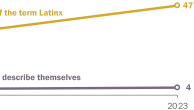Distinguishing the differences between the largest Hispanic groups, white Hispanics, and SOR Hispanics, is an imprecise exercise. Even among Hispanics who checked white in Census 2000, fewer than half (49 percent) also reported that they were white in a follow-up questionnaire (Bentley et al, 2000). Many white Hispanics (45 percent) offered a response of SOR in the follow-up study. Among SOR Hispanics identified in the 2000 Census more (67 percent) offered the same SOR response in the follow-up study.
Another source of imprecision is non-response. About one in every seven Hispanics is allocated to a race category because they skip the race question. When compared to white Hispanics, more SOR Hispanics skip the race question. In general, fewer white Hispanics skip the race question, but more offer an inconsistent response upon follow-up. On the other hand, among SOR Hispanics more skip the race question, but fewer change their response upon follow-up.
In spite of this imprecision, there appears to be small, but persistent differences between white Hispanics and SOR Hispanics. Due to the large sample size of the 5 percent PUMS dataset, t-tests for significance were nearly universally significant at the 5 percent level. The differences are significant when all census respondents are used in the analysis, and also when the data are limited to only those for whom race was not allocated. Furthermore, the differences can be identified using data from different sources and the generalization that SOR Hispanics occupy a somewhat less favorable socioeconomic status than white Hispanics holds true.




